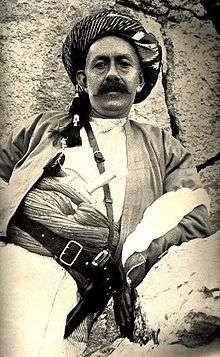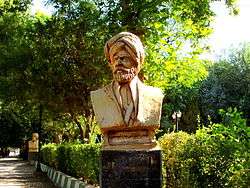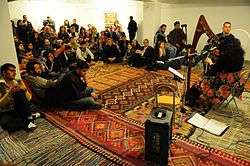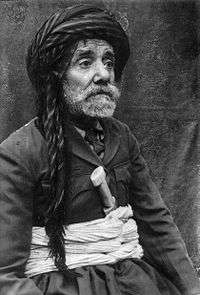Sulaymaniyah
| Sulaymaniyah سلێمانی Silêmanî السليمانية as-Sulaymāniyyah | |
|---|---|
|
Sulaymaniyah City Montage | |
 Sulaymaniyah | |
| Coordinates: IQ 35°33′26″N 45°26′08″E / 35.55722°N 45.43556°ECoordinates: IQ 35°33′26″N 45°26′08″E / 35.55722°N 45.43556°E | |
| Country |
|
| Autonomous region |
|
| Governorate | Sulaymaniyah Governorate |
| Government | |
| • Type | Council–manager |
| • Governor | Bakhtiar Abdul Rahman[1] |
| Elevation | 882 m (2,895 ft) |
| Population (2012) | |
| • Total | 1,500,000 |
| [2] | |
| Time zone | UTC+3 (UTC+3) |
| • Summer (DST) | not observed (UTC) |
Sulaymaniyah (Central Kurdish: سلێمانی, Silêmanî; Arabic: السليمانية, as-Sulaymāniyyah), also called Sulaimani or Slemani, is a city in Iraqi Kurdistan. Sulaymaniyah is surrounded by the Azmer Range, Goyija Range and the Qaiwan Range in the northeast, Baranan Mountain in the south and the Tasluja Hills in the west. The city has a semi-arid climate with very hot dry summers and cool wet winters. Sulaymaniyah served as the capital of the historic Kurdish principality of Baban from 1784 to 1850.
The modern city of Sulaymaniyah was founded on 14 November 1784 by the Kurdish prince Ibrahim Pasha Baban who named it after his father Sulaiman Pasha.[3] Because it was founded as the capital of a powerful Kurdish principality, Sulaymaniyah has developed into a large city with a population of more than 1,500,000 people. It is an important economic center for northern Iraq and has been named the cultural center for Sorani-speaking Kurds continuously since 1992.
From its foundation Sulaymaniyah was always a center of great poets, writers, historians, politicians, scholars and singers, such as Nalî, Mahwi, Piramerd, Muhammed Emin Zeki Bey, Taufiq Wahby, Sherko Bekas, Nuri Sheikh Salih Sheikh Ghani Barzinji, Bachtyar Ali, Mahmud Barzanji, Mawlawi, Mawlânâ Khâlid and Mustafa Zihni Pasha.[4][5]
History
The region of Sulaymaniyah was known as Zamwa prior to the foundation of the modern city in 1784. The capital of the Kurdish Baban principality (1649–1850), before Sulaymaniyah was a territory named "Qelaçiwalan". At the time of the Babani's rule there were major conflicts between the Safavid dynasty and the Ottoman Empire. Qelaçiwalan became a battleground for the two rivals.[6]
Being of strategic importance and lying deep inside Safavid territory, there was concern that Qelaçiwalan would be attacked and captured if the Babanies did not give the Safavids military support, as both Sultan Mahmud II and Nader Shah were trying to gain the support of the dispersed Kurdish Emirates.[6] This obliged Mahmud Pasha of Baban in 1781 to think about moving the center of its Emirate to another safer place. He chose Melkendî, then a village but now a district in central Sulaymaniyah, to construct a number of Serahs for his political and armed units.[6]
In 1783, Ibrahim Pasha of Baban became ruler of the Emirate and began the construction of a new city which would become the capital of the Baban Emirate. In 1784 he finished erecting a number of palaces for trade called Qeyserîs and bazaars, which were also used as baths, and began inviting people from the surrounding villages and Emirates to move to the newly established city. Soon Melkendî, which was originally intended to be the city itself, instead became one of its quarters and still is today.[6]

Sulaymaniyah has since its foundation been the center of Kurdish nationalism, and it was from here that Mahmud Barzanji sparked the first rebellion against the British occupation on 22 May 1919 with the arrest of British officials in Sulaymaniyah. He attempted to declare an independent Kingdom of Kurdistan on 10 October 1921, issuing a statement in Sulaymaniyah, then the capital of Kurdistan, to establish the Kingdom of Kurdistan.[6] Sheikh Mahmud Barzanji, now backed by the British, declared himself King of the Kingdom of Kurdistan.
The British occupation declared Sheikh Mahmud king in order to persuade the residents of Sulaymaniyah to stop their rebellion, but Sheikh Mahmud ruled independently from the British and wanted them out of the kingdom. As a result, in the same year he was exiled for several years to the Andaman islands in India by the British, only to return and raise another unsuccessful rebellion in 1923, centered in Sulaymaniyah.
In January 1926 the League of Nations gave the mandate over the territory to Iraq, with the provision for special rights for Kurds. In 1930-1931, Sheikh Mahmud Barzanji made his last unsuccessful attempt to free Kurdistan. He retreated into the mountains and later signed a peace accord with the Iraqi government and settled in the new Iraq in 1932.
The first and oldest neighborhood in the city is called "Goizha" (Kurdish: Goyija), which was named after the mountain overlooking the city. Sabûnkaran was of the city's first neighborhoods; its name means "those who make soap" in Kurdish and its residents were mainly involved in the soap industry. Cûlekan, the Jewish neighborhood, was mainly inhabited by Kurdish Jews. In the 1950s, after the establishment of the state of Israel, most of its inhabitants migrated to the newly created state.
On 23 April 1982, during the Iran–Iraq War, a demonstration broke out in the city against the arrests and torture of the city's youths who were accused of planning a revolt against the ruling Arab Ba'ath regime.
Following the Gulf War, a series of nationwide uprisings broke out across Iraq against the Ba'athist rule, including the 1991 uprising in Sulaymaniyah, led by the Kurdish separatist parties KDP and PUK. Since its successful liberation in 1991, Sulaymaniyah has been administered by the Kurdish Government (KRG) and serves as a principal metropolis of northern Iraq.
2011 Sulaymaniyah protests
In February 2011 multiple demonstrations took place in Sulaymaniyah against corruption and lack of services. The protest escalated and lasted for more than 40 days causing clashes between security forces and demonstrators until an eventual crackdown on the demonstrators left 10 dead and several hundred wounded.
Demographics
In 1820, only 26 years after the creation of the city, a British man named Rech visited the city and estimated that its population was more than ten thousand, containing 2,144 families of which 2,000 were Muslim, 130 Jewish, and 14 Christian.[7] Ottoman documents from 1907 suggest that there were 8,702 Muslim and 360 non-Muslim residents living in the city at that time. The Peshkawtin newspaper which was distributed in Sulaymaniyah in 1920 estimated its population to be around ten thousand. According to Iraqi government documents, by 1947 the number of residents had increased to 23,475; by 1998 to 548,747, and in 2009 to 2,000,000.[7]
The Assyrian community in the city is relatively new and has been small; there are several Assyrian churches in the city.
Geography and climate
The city is located in northern Iraq. Of the main population centers in the country, it is characterized by its cooler summer temperatures and its rainier winters. Average temperatures range from 0 °C (32 °F) to 39 °C (102 °F). In the winters, there can be a significant amount of snow. The city is actually known as the "windy city" in the region, due to the mountains that surround it. To the north, there are Goizha mountains and to the south the Chwarta, forcing the air in the city to be condensed and compacted and often quite rainy.
Snow is not frequent in winter, but snow has fallen in Sulaymaniyah in January 2008,[8] January 2010,[9] February 2010, February 2011, March 2012,[10] January 2013,[11] and January 2015.[12]
Köppen-Geiger climate classification system classifies its climate as dry-summer subtropical (Csa).[13]
| Climate data for Sulaymaniyah | |||||||||||||
|---|---|---|---|---|---|---|---|---|---|---|---|---|---|
| Month | Jan | Feb | Mar | Apr | May | Jun | Jul | Aug | Sep | Oct | Nov | Dec | Year |
| Average high °C (°F) | 7.8 (46) |
10.3 (50.5) |
15.5 (59.9) |
20.8 (69.4) |
28.4 (83.1) |
35 (95) |
38.8 (101.8) |
38.8 (101.8) |
34.7 (94.5) |
28.2 (82.8) |
18.7 (65.7) |
11.1 (52) |
24.01 (75.21) |
| Daily mean °C (°F) | 3.8 (38.8) |
5.6 (42.1) |
10.4 (50.7) |
15.2 (59.4) |
21.4 (70.5) |
27.6 (81.7) |
31.3 (88.3) |
31.4 (88.5) |
27.2 (81) |
21.1 (70) |
13.7 (56.7) |
6.7 (44.1) |
17.95 (64.32) |
| Average low °C (°F) | −0.2 (31.6) |
1 (34) |
5.3 (41.5) |
9.7 (49.5) |
14.5 (58.1) |
20.3 (68.5) |
23.9 (75) |
24.1 (75.4) |
19.7 (67.5) |
14.1 (57.4) |
7.6 (45.7) |
2.3 (36.1) |
11.86 (53.36) |
| Average precipitation mm (inches) | 129 (5.08) |
146 (5.75) |
132 (5.2) |
100 (3.94) |
41 (1.61) |
0 (0) |
0 (0) |
0 (0) |
0 (0) |
13 (0.51) |
74 (2.91) |
110 (4.33) |
745 (29.33) |
| Source: Climate-Data.org (altitude: 849m)[13] | |||||||||||||
| Climate data for Sulaymaniyah, South Kurdistan (1950-2000) | |||||||||||||
|---|---|---|---|---|---|---|---|---|---|---|---|---|---|
| Month | Jan | Feb | Mar | Apr | May | Jun | Jul | Aug | Sep | Oct | Nov | Dec | Year |
| Average high °C (°F) | 7.9 (46.2) |
10.3 (50.5) |
15.4 (59.7) |
20.8 (69.4) |
28.3 (82.9) |
35.1 (95.2) |
38.7 (101.7) |
38.9 (102) |
34.7 (94.5) |
28.1 (82.6) |
18.7 (65.7) |
11.1 (52) |
24 (75.2) |
| Daily mean °C (°F) | 3.9 (39) |
5.7 (42.3) |
10.3 (50.5) |
15.3 (59.5) |
21.4 (70.5) |
27.7 (81.9) |
31.3 (88.3) |
31.5 (88.7) |
27.2 (81) |
21.1 (70) |
13.2 (55.8) |
6.7 (44.1) |
17.9 (64.2) |
| Average low °C (°F) | −0.2 (31.6) |
1.1 (34) |
5.1 (41.2) |
9.7 (49.5) |
14.5 (58.1) |
20.3 (68.5) |
23.8 (74.8) |
24.1 (75.4) |
19.1 (66.4) |
14 (57) |
7.6 (45.7) |
2.3 (36.1) |
11.78 (53.19) |
| Average precipitation mm (inches) | 129 (5.08) |
146 (5.75) |
132 (5.2) |
100 (3.94) |
41 (1.61) |
0 (0) |
0 (0) |
0 (0) |
0 (0) |
13 (0.51) |
75 (2.95) |
111 (4.37) |
747 (29.41) |
| Source: WorldClim Global Climate Data[14][the data is inaccessible] | |||||||||||||
Education
Public education is free from primary school until graduation from university. The University of Sulaymaniyah was opened in 1968 with instruction in Kurdish, Arabic, and English. It has faculties in engineering, agriculture, the arts, science, and medicine. It is the largest university in South Kurdistan.
A new University of Sulaymaniyah[15] was established in 1991, teaching in Kurdish, English and Arabic. And the second new university is Sulaimani Polytechnic University[16] was established in 2012, teaching in Kurdish, English and Arabic.
In 2007 The American University of Iraq – Sulaimani,[17] (AUI-S) was a new addition to the American universities in the Middle East, holding its first classes in October 2007. Instruction is in English only.
The Komar University of Science and Technology,[18] (KUST) - Sulaymaniyah was established and licensed by the Ministry of High Education and Scientific Research in Kurdistan Region Government, by the official letter no. 17867/7 on 18 October 2009. KUST is a private university governed by a Board of Trustees and run by an Administration Council. Its main campus is located in Sulaymaniyah. KUST offered its first teaching classes in 2010 with an English language summer course (levels 1 and 3).[19]
Culture

Sulaymaniyah is considered the center of the Sorani Kurdish culture in Kurdistan. It is recognized officially as the cultural capital of South Kurdistan. Development of Sorani as a modern literary language started in this city in the early 19th century, when many Kurdish poets such as Nalî, Piramerd, Muhamed Amin Zaki, Abdulla Goran, Muhamad Salih Dilan, Ahmad Hardi, Ibrahim Ahmad, Nuri Sheikh Salih Sheikh Ghani Barzinji, Sherko Bekas, and Bachtyar Ali published their works.
The city is known for its open, relatively liberal and tolerant society when compared to other cities of Kurdistan. According to Al-Jazeera, the city has a Chinatown as a result of attracting foreign investment. Around 500 Chinese people reside in the city according to Al Arabiya.[20]
In 2006 the Movement for Change started in Sulaymaniyah and challenged what it called the "corrupt" and "nepotistic" Kurdish Government. The movement gained massive support from the city.
The two independent newspapers Hawlati[21] and Awena[22] and the two independent political magazines Lvin and Shock, are published and distributed in Sulaymaniyah city.
Sulaymaniyah assumes its own style of music which have borrowed from traditions of the city, Muhamad Salih Dilan is widely considered to be the greatest singer from the city and had the greatest role in developing Kurdish maqam. The city is also considered to be the birthplace of modern Kurdish music, There are a number of musical groups formed since 1950, including band Mawlawi (supervised by the artist Qadir Dylan), the band Sulaymaniyah, the band Sulaymaniyah University, the band Sulaymaniyah Girls, led by the Sulaymaniyah Orchestra artist Anwar qaradaghi after the 1991 uprising.
Sulaymaniyah is the only city in South Kurdistan that regularly celebrates world music day or Fête de la Musique. In one trip to the city, a journalist working for the BBC wrote about Sulaymaniyah's distinct culture: "Culture is hugely important to the Kurdish people, especially in Sulaymaniyah, but there is a strong pull to the west--modernisation and consumerism--driven perhaps by the satellite televisions they have had access to since they started running their own affairs...And at the university, students mill around the campus, chattering with each other and doing some last-minute cramming for their exams. The war only stopped lectures for a few weeks. There are probably more women than men and they are happy to air their views to anyone who asks."[23]
Economy
The Sulaymaniyah Governorate has much fertile land such as the Sharazur and Bitwen plains which are considered two of the most fertile plains in the Middle East. Historically, Sulaymaniyah was mainly agricultural and one of the major suppliers of wheat and other agricultural products. Its role declined due to the policies of Saddam Hussein aimed at reducing the city's economic potential as it was a center of the Kurdish revolution.
Since 2003 Iraq has seen a huge economic boom. Sulaymaniyah's economy today relies on tourism, agriculture[24] and a number of small factories, most of which are involved in the building trade.
In 2004 the Comprehensive Food Security and Vulnerability Analysis in Iraq released an in-depth survey of the Sulaymaniyah Governorate in which they surveyed each city. In this survey one can see the economic boom of 2003 mentioned earlier.[25]
Tourism


The city was visited by more than 60,000 tourists in 2009.[26] Sulaymaniyah attracted more than 15,000 Iranian tourists in the first quarter of 2010, many drawn by the fact it is not subject to strict laws faced at home. Newroz 2010 drew an exodus of Iranian tourists choosing to celebrate the event in the region.[27]
In Sulaymaniyah you are surrounded by a variety of business venues and tourist attractions that bring delegates and tourists to this region every year. Combined with the comforts and convenience of the Millennium & Copthorne Hotels and you have yourself an exhilarating package of choosing among three fascinating hotels: Grand Millennium Sulaimani; Millennium Kurdistan Hotel and Spa, a 5 star hotel; Copthorne Hotel Baranan a 4 star hotel. There are many modern hotels in Sulaymaniyah such as the High Crest Hotel, the Ramada Hotel, the Areen Hotel which overlooks the Azadi park and the mountain of Azmar, and the Sulaymaniyah Palace Hotel.
- Sulaimani Museum: It is the second biggest museum after the national museum in Baghdad. It is home to many Kurdish and ancient Persian artifacts dating back to 1792–1750 BC.[28]
.jpg)
- Amna Suraka Museum (Kurdish:"Red Intelligence Museum"): Located in a former Ba'ath intelligence headquarters and prison, it draws particular attention to the Ba'ath regime's brutal treatment of local Kurds. Visitors are guided through the prisons and interrogation rooms. The museum features many Soviet-era armored fighting vehicles.
Transportation
The city is dependent on road transport. On 20 July 2005, Sulaimaniyah International Airport opened, with regular flights to various European destinations such as Frankfurt, Stockholm, Malmö, Munich, Eindhoven and Düsseldorf as well as Middle Eastern cities like Dubai, Amman, Doha, Beirut, Damascus, Istanbul and Ankara.
Notable people
- Hadhrat Mawlânâ Khâlid-i Baghdâdî (1779–1827), sufist and Islamic thinker
- Salim (1800–1866), poet.
- Nalî (1800–1873), poet.
- Mahwi (1830–1906), poet.
- Said Pasha Kurd, (1834-1907), Ottoman statesman.
- Mustafa Zihni Pasha (1838–1911), Ottoman official, Kurdish nationalist.
- Şerif Pasha, (1865-1951), Ottoman diplomat, ambassador and statesman.
- Mustafa Yamulki (1866-1936), Minister of Education in the Kingdom of Kurdistan.
- Haji Mala Saeed Kirkukli Zada (1866–1937), Minister of Justice in the Kingdom of Kurdistan.
- Piramerd (1867–1950), poet and journalist.
- Mahmud Barzanji (1878–1956), king of Kurdistan (1922–1924)
- Muhamed Amin Zaki (1880–1948), historian, statesman and politician.
- Hapsa Xan (1881-1953), started the enlightenment movement for Kurdish women
- Taufiq Wahby (1891–1984), linguist, politician and poet.
- Sheikh Nuri Sheikh Salih Sheikh Ghani Barzinji (1896–1958), journalist and poet.
- Ahmad Mukhtar Baban (1900–1976), prime Minister of Iraq 1958.
- Abdulla Goran (1904–1962), founder of modern Kurdish poetry
- Ibrahim Ahmad (1914–2000), novelist, poet and translator.
- Ahmad Hardi (1922—2006), poet.
- Muhamad Salih Dilan (1927–1990), prominent musician and poet.
- Shahab Sheikh Nuri (1932–1976), Kurdish freedom movement activist in Iraq.
- Jamal Nebez (born 1933), linguist.
- Mahmoud Othman (born 1938), politician.
- Jalal Dabagh (born 1939), politician and writer.
- Sherko Bekas (1940-2013), prominent contemporary poet.
- Nawshirwan Mustafa (born 1944), politician and media proprietor.[29]
- Bahram Resul (born 1945), medical chemist and inventor
- Dilshad Meriwani, (1947-1989), actor, poet, writer, songwriter, film director, historian, activist and journalist.
- Rizgar Mohammed Amin (born 1958), chief judge.
- Bachtyar Ali (born 1960) intellectual, novelist
- Barham Salih (born 1960) politician, former PM of South Kurdistan.
- Mariwan Kanie (born 1966), intellectual.
- Xalîd Reşîd (born 1968), musician
- Shwan kamal (born 1967), sculptor
Notable companies
Sites
- Tomb of king Cyaxares of Media (region), Qyzqapan
Literature
Sulaymaniyah is the partial setting in the young adult novel Kiss the Dust.
Diplomatic missions
- Islamic Republic of Iran, Girdi Consulkhana
Twin towns – Sister cities
Photo gallery
-
.jpg)
A view of Dukan in near Sulaymaniyah City
-
Men rally at the day of the Kurdish new year Newroz; Events like this gained the city its reputation of being the centre for Kurdish patriotism
-

Kurdistan flag in Azadi park of Sulaymaniyah.
-

Grand Millennium Sulaimani Hotel.
-
_City_-_Kurdistan_-_Iraq.jpg)
Sulaimani City in 2015
See also
- Arbil
- Dahuk
- Dohuk Governorate
- Erbil Governorate
- Kurdistan
- Ranya
- South Kurdistan
- Sulaymaniyah Governorate
- Chaldean Catholic Eparchy of Sulaimaniya (former Eastern Catholic diocese)
References
- ↑ "Sulaimani Polytechnic University". http://spu.edu.iq/. 2015-06-13. Retrieved 2015-06-13. External link in
|publisher=(help) - ↑ "Sulaimaniyah\'s population exceeded one million and a half million". Kurdiu.org. 2012-07-04. Retrieved 2012-08-09.
- ↑ Ali, Meer Ako. "Sulaimany: 227 years of glory". kurdistantribune.com. Retrieved 2 January 2014.
- ↑ Salih Rasha, Akram. Sulaymaniyah 200 Years. Sulaymaniyah, Kurdistan. pp. 503–504.
- ↑ slimany
- 1 2 3 4 5 "The Leading Suly Government Site on the Net". sulygov.com. Retrieved 2012-08-09.
- 1 2 ckb:سلێمانی
- ↑ "Iraq under cold front bringing snow with below zero temperatures". Indian Muslims. Kuwait News Agency (KUNA). 11–12 January 2008. Retrieved 3 March 2013.
BAGHDAD, Jan 11 (KUNA) -- snow fell on large areas of Iraq following two days of low temperatures.
- ↑ "Snow covers Sulaimaniya". National Iraqi News Agency (NINA). 26 January 2010. Retrieved 3 March 2013.
Sulaimaniya (NINA) –The city of Sulaimaniya witnessed a heavy fall of snow that covered the entire city since Monday midnight. Reporter of the National Iraqi News Agency said “The citizens of Sulaimaniya woke up on Tuesday morning to see their city covered with snow and the street painted in white color.”
- ↑ "Heavy Snow Blankets Sulaimaniya". Iraq Updates. 3 March 2012. Retrieved 3 March 2013.
- ↑ "Unusually heavy snow hits Iraq’s Sulaimaniya". Al Arabiya. Reuters. 14 January 2013. Retrieved 3 March 2013.
An unusually heavy snowstorm blanketed Sulaimaniya city, in northern Iraq’s autonomous Kurdish region, on Saturday (January 12) as severe weather conditions continue to sweep through the region.
- ↑ "11 Refugee Children Freeze to Death in Kurdistan Camps". Erbil. 12 January 2015. Archived from the original on 3 February 2015. Retrieved 3 February 2015.
- 1 2 "Climate: Sulaymaniyah - Climate graph, Temperature graph, Climate table". Climate-Data.org. Retrieved 2014-01-04.
- ↑ "WorldClim Global Climate Data Grids". WorldClim. Retrieved 14 September 2011. [data is inaccessible]
- ↑ "University of Sulaimani". Univsul.org. Retrieved 2012-08-09.
- ↑ "Sulaimani Polytechnic University". spu.edu.iq. Retrieved 2014-10-24.
- ↑ auis.org
- ↑ komar.edu.iq
- ↑ Archived 3 June 2011 at the Wayback Machine
- ↑ "Iraqi Kurdistan sees 1st emerging China town".
- ↑ "Hawlati.info". Hawlati.info. Retrieved 2014-08-26.
- ↑ "ئاوێنە نیوز". Awene.com. Retrieved 2014-08-26.
- ↑ "Kurdistan diary: Day Three". KurdishGlobe. 2006-10-28. Retrieved 2012-08-09.
- ↑ "Slemani". Investpromo.gov.iq. Retrieved 2012-08-09.
- ↑ Archived 14 August 2011 at the Wayback Machine
- ↑ "Rudaw.NL, dé Opinieblog…". Rudaw.nl. Retrieved 2012-08-09.
- ↑ "Rudaw.NL, dé Opinieblog…". Rudaw.nl. Retrieved 2012-08-09.
- ↑ "Suleimaniya Museum: a small place for a great civilization". KurdishGlobe. 2008-02-13. Retrieved 2012-08-09.
- ↑ "Wusha Corporation". Wusha.net. Retrieved 2012-08-09.
- ↑ "Tucson Sister Cities". Interactive City Directory. Sister Cities International. Retrieved 4 September 2013.
- ↑ اعلام خواهرخواندگی سلیمانیه عراق و ناپل ایتالیا , Kurdpress (Persian), 30 April 2013.
External links
![]() Media related to Sulaymaniyah at Wikimedia Commons
Media related to Sulaymaniyah at Wikimedia Commons
| |||||||||||||||||||||||||||||||||||||

.jpg)

